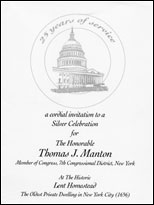|
History
 During
the restoration, the Smiths discovered that the house actually began as a one-room dwelling built
of timber and fieldstone on or about 1654 by Abraham Riker.
This agrees with historical data since found which states that Abraham
Riker lived there in 1655 when it was known as “the poor farm.” It also
agrees with the dates found in the family plot. The facts confirm that this dwelling is the oldest dwelling in New York
City that is still a dwelling. They likewise confirm that the house has had only
three owners: the Riker-Lent family, William Gooth and the Smiths, who
bought the property in 1975. During
the restoration, the Smiths discovered that the house actually began as a one-room dwelling built
of timber and fieldstone on or about 1654 by Abraham Riker.
This agrees with historical data since found which states that Abraham
Riker lived there in 1655 when it was known as “the poor farm.” It also
agrees with the dates found in the family plot. The facts confirm that this dwelling is the oldest dwelling in New York
City that is still a dwelling. They likewise confirm that the house has had only
three owners: the Riker-Lent family, William Gooth and the Smiths, who
bought the property in 1975.
The New York Genealogical and
Biographical Record dated July, 1994, describes how the name Lent came into
being. In a will executed in the
Netherlands in 1661, Abraham’s full name is given as Abraham Rycken Van Lent.
In a report published by the National
Americana Society dated 1931 it is stated that the Riker family dates back to
the First crusade in 1096. Among the followers of Walter the Penniless was a Knight
named Hans von Ryken, a petty noble of lower Saxony who commanded a troop of 800
men. The family enjoyed what was
known as allodial rights... holding lands in fee. Allodium is a legal term for lands which are the absolute property of
their owner, and not subject to any service or acknowledgment to a supervisor. It is the opposite of feodum or fief. For several centuries, the family held positions of influence as merchant
princes in the city of Amsterdam. However,
when the Hollanders rebelled against the yoke of Spain, the Rykens suffered for
their patriotism... and, Abraham sought to retrieve his fortune in the New
World. Judging from the papers
recovered from the attic of the Homestead and donated to the Long Island
Historical Society, the family became very wealthy and prominent.
Through the
centuries the Rikers altered their names from time to time, some using Ryker and
some using Riker. The Ryker-Riker Historical Society formed in the Midwest to
help trace the family ancestry.
 The Smiths have received several
awards, certificates of appreciation and proclamations from governmental
officials including former Mayor Ed Koch, Former Queens Borough President Claire Shulman, and Assemblyman Ivan C. Lafayette. Congressman
Tom Manton raised the American flag over the Cemetery at a ceremony in June,
1988, with help of the Marine Corp who played "To The Colors" on the bugle. The flag had been flown over
the U.S. Capitol prior to its arrival. The
flag raising ceremony was to honor such men as Capt. Abraham Riker who died at
Valley Forge on May 7, 1778, William
James McNevin, an Irish patriot who was prominent in the Revolution, Dr. Berrien
Riker, Surgeon-General of the Revolutionary Army and John Lawrence Riker who
fought during the War of 1812. The Smiths have received several
awards, certificates of appreciation and proclamations from governmental
officials including former Mayor Ed Koch, Former Queens Borough President Claire Shulman, and Assemblyman Ivan C. Lafayette. Congressman
Tom Manton raised the American flag over the Cemetery at a ceremony in June,
1988, with help of the Marine Corp who played "To The Colors" on the bugle. The flag had been flown over
the U.S. Capitol prior to its arrival. The
flag raising ceremony was to honor such men as Capt. Abraham Riker who died at
Valley Forge on May 7, 1778, William
James McNevin, an Irish patriot who was prominent in the Revolution, Dr. Berrien
Riker, Surgeon-General of the Revolutionary Army and John Lawrence Riker who
fought during the War of 1812.
Many other dignitaries such as
New York City Council Speaker and Majority Leader Peter Vallone, Queens Borough
President Helen Marshall, Queens
historian Stanley Cogan, Congressman Joseph Crowley, Justice Burton Roberts and
many descendants of the Riker family have come to visit the Dutch Colonial farm
house. The Ryker-Riker Historical Society made them honorary members
of the society in gratitude for what the
Smiths have accomplished. And, The
New York Metropolitan Chapter of the American Society of Interior Designers
wrote after visiting the "farm house... ."—"We were deeply interested in
the form, the construction and the architectural elements of the house. You gave us the opportunity to feel, see and digest the fabric of your
"Gem of History". We were
touched by your devotion to the house, and grounds. We wish you great satisfaction in your restoration efforts."
Click
Here to Learn More About the Restoration of the House
|